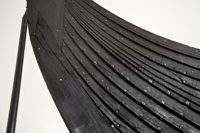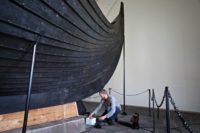 The largest preserved Viking ship in Norway, the Gokstad ship at Oslo’s Viking Ship Museum, is cracking. Two large cracks have appeared and museum conservators are sounding the alarm that the ship needs a comprehensive change to its support infrastructure before disaster strikes.
The largest preserved Viking ship in Norway, the Gokstad ship at Oslo’s Viking Ship Museum, is cracking. Two large cracks have appeared and museum conservators are sounding the alarm that the ship needs a comprehensive change to its support infrastructure before disaster strikes.
“When 1,000-year-old ship planks begin to weaken, the situation is extremely serious,” said Håkon Glørstad, director of the University of Oslo’s Museum of Cultural History that’s responsible for the Viking ships. “Wood that’s so old doesn’t have the same flexibility as modern wood and can totally collapse, quickly and without warning.”
Glørstad told newspaper Aftenposten on Monday that in its current location, “we can’t develop the overall support systems needed to secure the ship’s entire hull.” He said the current base is no longer adequate and the space around the ship too confined.
The bow and the stern are the most unstable parts of the ship. The rest of the hull is braced by a wood base and 12 additional supports. The bow didn’t get its own supports until last year when three were installed to help contain the shifts in movement that cause cracking. Last month supports were added to the stern.
 The new supports have sensor technology that allow them to pull double-duty: keeping the ship as stable as possible and measuring its movements. The data revealed that the Gokstad ship is experiencing significant vertical and horizontal movements, enough to move the ship millimeters in both directions. That may not sound like a lot, but it’s huge in conservation terms and significantly above the limit of what a ship built in the 820s and buried for a thousand years can withstand.
The new supports have sensor technology that allow them to pull double-duty: keeping the ship as stable as possible and measuring its movements. The data revealed that the Gokstad ship is experiencing significant vertical and horizontal movements, enough to move the ship millimeters in both directions. That may not sound like a lot, but it’s huge in conservation terms and significantly above the limit of what a ship built in the 820s and buried for a thousand years can withstand.
 Extra supports are only an emergency measure for the short-term. The Norwegian government has allocated funds to construct a new state-of-the-art building a hundred yards from the current one, but the grant hasn’t come through yet and construction can’t begin until it has. The most optimistic projection of when the new facility will be complete is 2025.
Extra supports are only an emergency measure for the short-term. The Norwegian government has allocated funds to construct a new state-of-the-art building a hundred yards from the current one, but the grant hasn’t come through yet and construction can’t begin until it has. The most optimistic projection of when the new facility will be complete is 2025.
The Gokstad ship was unearthed in 1880 in Sandefjord, Vestfold, southeastern Norway. The mound where it was found was on a farm, and the sons of the owner began digging it out of the frozen ground looking for a royal treasure that was rumored to be buried there. Archaeologists were able to take over the job and unearthed the 9th century clinker-built ship, the remains of an adult man with cutting wounds indicating death in battle and highly significant grave goods although any gold, silver or weapons buried with him had been looted centuries earlier. It has been on display at the museum since 1932.
The other two Viking ships in the museum, the elaborately decorated Oseberg ship (discovered in 1903) and the Tune warship (the first Viking ship ever excavated, discovered in 1867), are more stable at the moment, but Oseberg’s enormous complement of wood artifacts have dangerously softened because of the alum treatment they received in 1904. Experts have been working non-stop since 2014 on saving them. The long-term condition, even survival, of the ships and their contents require that issues be addressed as they arise, not years in the future.
Eek!
It looks like the ship had many repairs in its working lifetime, with a variety of wood and rivet types. I suppose that was normal for this kind of ship.
It probably needs an occasional lengthy (or possibly continuous) submerging to let the wood rehydrate; after all it was designed to be wet most of the time. And since it’s been out of the bog for a lot of years… the wood is finally drying out enough to begin to shrink (yes, it can take this long for the wood to lose that much moisture, especially when the surface is treated). Hence, cracks.
This is the sort of thing any experienced woodturner deals with. Wood tends to crack along stress lines as it dries (wood is under internal stress at right angles to the length of the grain). This ship is not really all that different.